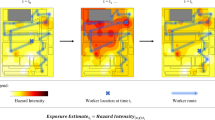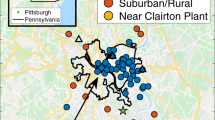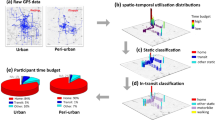Abstract
This paper describes the study design, measurement protocols, and results of a project examining residential magnetic-field exposures at eight sites across the contiguous United States. The goal of the project was to investigate surrogates that have been used in epidemiologic studies to characterize residential magnetic-field exposure. These surrogates include: personal-exposure (PE), fixed-location long-term (LT), and outside and inside point-in-time (PIT) magnetic-field measurements; net-service (or ground current) measurements; and the “wire-code category” of the residence. (The latter is a surrogate for magnetic-field exposure based on the nature and proximity of electric power lines outside the house.) Measurements were conducted on four visits to each of eight sites between January 1994 and June 1997 for a study population of 218 single-unit detached dwellings. Information on the residence, residents, and neighborhood was collected. A simple random sample of 392 single-unit detached dwellings at the sites was used to create a weighted sample of houses representative of the population of single-unit residences. The correlations among the various types of 60-Hz magnetic-field measures were relatively strong (Pearson r>0.74, Spearman ρ>0.78). Variability of PE and LT measurements, as measured by the standard deviations during a visit, was independent of wire-code category. Visit means for PE, LT, and outside and inside PIT were well correlated over periods between visits of from 1.5 to 20 months (r>0.62, ρ>0.76). These results support the use of survey measurements (less demanding than personal monitoring) to represent exposure that occurred up to 20 months in the past. The principal component of the total variance in PE measurements was the between-house variance; between-visit and between-site variances were generally less important. This supports the sampling of many houses with relatively few visits in residential exposure characterization studies. There was a trend for presumably higher wire-code categories to be associated with higher field summary measures for all summary measures related to magnetic-field magnitude, including PE and LT resultant, and inside and outside resultant (60 Hz) and harmonics. However, because of the overlap in field levels between categories, wire code was not a good predictor of magnetic-field levels, accounting for less than 21% of the variance in magnetic-field measurements.
This is a preview of subscription content, access via your institution
Access options
Subscribe to this journal
Receive 6 print issues and online access
$259.00 per year
only $43.17 per issue
Buy this article
- Purchase on Springer Link
- Instant access to full article PDF
Prices may be subject to local taxes which are calculated during checkout






Similar content being viewed by others
References
Barnes F Wachtel H Savitz D Fuller J, 1989. Use of wiring configuration and wiring codes for estimating externally generated electric and magnetic fields, Bioelectromagnetics. 10: 13–21
Bracken TD Rankin RF Senior RS Alldredge JR, 1994 The EMDEX Project: residential study. Final report. EPRI: Palo Alto, CA
Bracken TD Rankin RF Senior RS Dudman JW, 1998 Association of wire code configuration with long-term average 60-Hz magnetic field exposure. Final report. Research Project 3533-01. EPRI: Palo Alto, CA
Bureau of the Census 1992 Census of Population and Housing — Summary Population and Housing Characteristics: United States. 1990 CPH-1-1. U.S. Government Printing Office: Washington, DC
Dockerty JD Elwood JM Skegg DCG Herbison GP, 1998. Electromagnetic-field exposures and childhood cancers in New Zealand, Cancer Causes Control. 9: 299–309
Dovan T Kaune WT Savitz DA, 1993. Repeatability of residential power frequency magnetic fields and wire codes, Bioelectromagnetics. 14: 145–159
Green LM Miller AB Agnew DA Greenberg ML Li J Villeneuve PJ Tibshirani R, 1999. Childhood leukemia and personal monitoring of residential exposures to electric and magnetic fields in Ontario, Canada, Cancer Causes Control. 10: 233–243
Green LM Miller AB Villeneuve PJ Agnew DA Greenberg ML Li J Donnelly KE, 1999. A case–control study of childhood leukemia in southern Ontario, Canada, and exposure to magnetic fields in residences, Int J Cancer. 82 2 161–170 (Jul 19)
Jones TL Shih CH Thurston DH Ware BJ Cole P, 1993. Selection bias from differential residential mobility as an explanation for associations of wire codes with childhood cancer, J Clin Epidemiol. 46: 545–548
Kaune WT Savitz DA, 1994. Simplification of the Wertheimer–Leeper wire code, Bioelectromagnetics. 15: 275–282
Kaune WT Bracken TD Senior RS Rankin RF Niple JE Kavet RI, 2000. Rate of occurrence of transient magnetic-field events in U.S. residences, Bioelectromagnetics. 21: 197–213
Kaune WT Stevens RG Callahan NJ Severson RK Thomas DB, 1987. Residential magnetic and electric fields, Bioelectromagnetics. 8: 315–335
Kaune WT Stevens RG Callahan NJ Severson RK Thomas DB, 1987b Residential magnetic and electric fields measured over 24-h periods. Final report, Power Lines Project 21082-18. Health Research: Albany, NY
Kavet R, 1999. ELF magnetic fields, transients, and TWA metrics, Radiat Prot Dosim. 83: 29–40
Kheifets L Kavet R Sussman S, 1997. Wire codes, magnetic fields, and childhood cancer, Bioelectromagnetics. 18: 99–110
Leeper E Wertheimer N Savitz D Barnes F Wachtel H, 1991. Brief communication: modification of the 1979 “Denver Wire Code” for different wire or plumbing types, Bioelectromagnetics. 12: 315–318
Linet MS Hatch EE Kleinerman RA Robison LL Kaune WT Friedman DR Severson RK Haines CM Hartsock CT Niwa S Wacholder S Tarone RE, 1997. Residential exposure to magnetic fields and acute lymphoblastic leukemia in children, N Engl J Med. 337(1, 3 July): 1–7
London SJ Thomas DC Bowman JD Sobel E Cheng TC Peters JM, 1991. Exposure to residential electric and magnetic fields and risk of childhood leukemia, Am J Epidemiol. 134: 923–937
McBride ML Gallagher RP Theriault G Armstrong BG Tamaro S Spinelli JJ Deadman JE Fincham S Robson D Choi W, 1999. Power-frequency electric and magnetic fields and risk of childhood leukemia in Canada, Am J Epidemiol. 149(9): 831–842 (May 1)
Michaelis J Shuz J Meinert R Zemann E Grigat JP Kaatsch P Kaletsch U Miesner A Brinkmann K Kalkner W Karner H, 1998. Combined risk estimates for two German population based case–control studies on residential magnetic fields and childhood acute leukemia, Epidemiology. 9: 92–94
National Research Council 1997 Possible health effects of exposure to residential electric and magnetic fields. National Academy Press: Washington, DC191 pages
Poole C Trichopoulos D, 1991. Extremely low-frequency electric and magnetic fields and cancer, Cancer Causes Control. 2: 267–276
Portier CJ Wolfe MS (Eds.) 1998 Assessment of health effects from exposure to power-line frequency electric and magnetic fields (NIH Publication No. 98-3981)U.S. National Institutes of Health: Research Triangle Park, NC 522 pages
Rankin RF Bracken TD Association of wire code configuration with long-term average 60-Hz magnetic field exposure: interim report on study progress EPRI TR-104656, Research Project 3533-01, November EPRI: Palo Alto, CA 1994
Savitz DA Wachtel H Barnes FA John EM Tvrdik JG, 1988. Case–control study of childhood cancer and exposure to 60-hertz electric and magnetic fields, Am J Epidemiol. 128: 21–38
Tarone RE Kaune WT Linet MS Hatch EE Kleinerman RA Robison LL Boice JD Wacholder S, 1998. Residential wire codes: reproducibility and relation with measured magnetic fields, Occup Environ Med. 55(5, May) 333–339
Wertheimer N Leeper E, 1979. Electrical wiring configurations and childhood cancer, Am J Epidemiol. 109: 273–284
Wertheimer N Leeper E, 1982. Adult cancer related to electrical wires near the home, Int J Epidemiol. 11: 345–355
Zaffanella LE, 1993 Survey of residential magnetic field sources EPRI TR-102759-V1, Project 3335-02 Electric Power Research Institute: Palo Alto, CA
Zaffanella LE Kalton GW, 1998 Survey of personal magnetic field exposure. Phase II: 1000-person survey interim report EMF RAPID Program Engineering Project #6 Enertech Consultants: Lee, MA
Acknowledgements
Funding for this project was provided by EPRI (WO3533-01), as well as by the Tennessee Valley Authority and the Empire State Electric Research oration. The authors thank the participating utilities and staff for their efforts in soliciting customer participation, wire-coding and selecting residences, and accompanying the measurement technicians to the houses. Under the direction of Peter Walter and John Longo, the CH2M HILL measurement technicians did an admirable job of collecting data and maintaining data integrity, often in adverse weather conditions. J. Richard Alldredge of Washington State University provided valuable consultation on the statistical analyses performed by the project. Sharon S. Bouray and Joseph Dudman of T. Dan Bracken, Inc., assisted in the preparation of the document, and data management, respectively.
Author information
Authors and Affiliations
Corresponding author
Rights and permissions
About this article
Cite this article
RANKIN, R., DAN BRACKEN, T., SENIOR, R. et al. Results of a multisite study of U.S. residential magnetic fields. J Expo Sci Environ Epidemiol 12, 9–20 (2002). https://doi.org/10.1038/sj.jea.7500196
Received:
Accepted:
Published:
Issue Date:
DOI: https://doi.org/10.1038/sj.jea.7500196
Keywords
This article is cited by
-
Impact of extremely low-frequency magnetic fields on human postural control
Experimental Brain Research (2019)
-
Temporal variability of daily personal magnetic field exposure metrics in pregnant women
Journal of Exposure Science & Environmental Epidemiology (2015)
-
Analyses of magnetic-field peak-exposure summary measures
Journal of Exposure Science & Environmental Epidemiology (2006)
-
Wire coding in the EMF and Breast Cancer on Long Island Study: relationship to magnetic fields
Journal of Exposure Science & Environmental Epidemiology (2003)
-
Use of short-term measurements for assessing temporal variability of residential ELF magnetic field exposure
Journal of Exposure Science & Environmental Epidemiology (2003)



